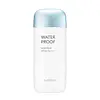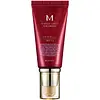Missha All-Around Safe Block Waterproof Sun Milk SPF 50+ Versus Missha M Perfect Cover BB Cream SPF 42
What's inside
What's inside
 Key Ingredients
Key Ingredients

 Benefits
Benefits

 Concerns
Concerns

 Ingredients Side-by-side
Ingredients Side-by-side

Hydrolyzed Chestnut Extract
Skin ProtectingCyclopentasiloxane
EmollientHomosalate
Skin ConditioningSilica
AbrasiveEthylhexyl Salicylate
UV AbsorberTitanium Dioxide
Cosmetic ColorantLauryl PEG-10 Tris(Trimethylsiloxy)Silylethyl Dimethicone
EmulsifyingDiethylamino Hydroxybenzoyl Hexyl Benzoate
UV FilterGlycerin
HumectantC12-15 Alkyl Benzoate
AntimicrobialAlcohol Denat.
AntimicrobialBis-Ethylhexyloxyphenol Methoxyphenyl Triazine
Skin ConditioningIsopropyl Palmitate
EmollientAloe Barbadensis Leaf Extract
EmollientPsidium Guajava Leaf Extract
AstringentVerbena Officinalis Leaf Extract
MaskingSmilax China Bark Extract
Skin ConditioningUlmus Davidiana Root Extract
Skin ConditioningEucalyptus Alba Leaf Extract
Skin ConditioningWater
Skin ConditioningButylene Glycol
HumectantDimethicone
EmollientMagnesium Sulfate
Aluminum Hydroxide
EmollientStearic Acid
CleansingQuaternium-18 Bentonite
PEG-10 Dimethicone
Skin ConditioningDimethicone/Vinyl Dimethicone Crosspolymer
Skin ConditioningTriethoxycaprylylsilane
Acrylates/Dimethicone Copolymer
Skin ConditioningSilica Dimethyl Silylate
EmollientSodium Benzoate
MaskingTocopheryl Acetate
AntioxidantPotassium Sorbate
PreservativeVp/Hexadecene Copolymer
Vp/Va Copolymer
Disodium EDTA
Phenoxyethanol
PreservativeLinalool
PerfumingBenzyl Salicylate
PerfumingLimonene
PerfumingGeraniol
PerfumingHexyl Cinnamal
PerfumingHydrolyzed Chestnut Extract, Cyclopentasiloxane, Homosalate, Silica, Ethylhexyl Salicylate, Titanium Dioxide, Lauryl PEG-10 Tris(Trimethylsiloxy)Silylethyl Dimethicone, Diethylamino Hydroxybenzoyl Hexyl Benzoate, Glycerin, C12-15 Alkyl Benzoate, Alcohol Denat., Bis-Ethylhexyloxyphenol Methoxyphenyl Triazine, Isopropyl Palmitate, Aloe Barbadensis Leaf Extract, Psidium Guajava Leaf Extract, Verbena Officinalis Leaf Extract, Smilax China Bark Extract, Ulmus Davidiana Root Extract, Eucalyptus Alba Leaf Extract, Water, Butylene Glycol, Dimethicone, Magnesium Sulfate, Aluminum Hydroxide, Stearic Acid, Quaternium-18 Bentonite, PEG-10 Dimethicone, Dimethicone/Vinyl Dimethicone Crosspolymer, Triethoxycaprylylsilane, Acrylates/Dimethicone Copolymer, Silica Dimethyl Silylate, Sodium Benzoate, Tocopheryl Acetate, Potassium Sorbate, Vp/Hexadecene Copolymer, Vp/Va Copolymer, Disodium EDTA, Phenoxyethanol, Linalool, Benzyl Salicylate, Limonene, Geraniol, Hexyl Cinnamal
Water
Skin ConditioningCyclomethicone
EmollientEthylhexyl Methoxycinnamate
UV AbsorberZinc Oxide
Cosmetic ColorantPropylene Glycol
HumectantTitanium Dioxide
Cosmetic ColorantCaprylic/Capric Triglyceride
MaskingPEG-10 Dimethicone
Skin ConditioningCetyl PEG/PPG-10/1 Dimethicone
EmulsifyingArbutin
AntioxidantParaffinum Liquidum
EmollientGlycerin
HumectantCI 77492
Cosmetic ColorantPolyethylene
AbrasiveTalc
AbrasivePhenyl Trimethicone
Skin ConditioningBeeswax
Emulsion StabilisingSodium Chloride
MaskingCI 77491
Cosmetic ColorantCI 77499
Cosmetic ColorantMethylparaben
PreservativeDimethicone
EmollientPropylparaben
PreservativeRosa Canina Fruit Oil
EmollientSimmondsia Chinensis Seed Oil
EmollientSqualane
EmollientHydrolyzed Collagen
EmollientMacadamia Ternifolia Seed Oil
EmollientDisodium EDTA
Adenosine
Skin ConditioningAlgae Extract
EmollientRosmarinus Officinalis Leaf Extract
AntimicrobialChamomilla Recutita Flower Extract
MaskingSodium Hyaluronate
HumectantFagus Sylvatica Bud Extract
TonicCeramide 3
Skin ConditioningParfum
MaskingHydroxyisohexyl 3-Cyclohexene Carboxaldehyde
MaskingButylphenyl Methylpropional
PerfumingBenzyl Salicylate
PerfumingHydroxycitronellal
PerfumingAlpha-Isomethyl Ionone
PerfumingHexyl Cinnamal
PerfumingLinalool
PerfumingCitronellol
PerfumingWater, Cyclomethicone, Ethylhexyl Methoxycinnamate, Zinc Oxide, Propylene Glycol, Titanium Dioxide, Caprylic/Capric Triglyceride, PEG-10 Dimethicone, Cetyl PEG/PPG-10/1 Dimethicone, Arbutin, Paraffinum Liquidum, Glycerin, CI 77492, Polyethylene, Talc, Phenyl Trimethicone, Beeswax, Sodium Chloride, CI 77491, CI 77499, Methylparaben, Dimethicone, Propylparaben, Rosa Canina Fruit Oil, Simmondsia Chinensis Seed Oil, Squalane, Hydrolyzed Collagen, Macadamia Ternifolia Seed Oil, Disodium EDTA, Adenosine, Algae Extract, Rosmarinus Officinalis Leaf Extract, Chamomilla Recutita Flower Extract, Sodium Hyaluronate, Fagus Sylvatica Bud Extract, Ceramide 3, Parfum, Hydroxyisohexyl 3-Cyclohexene Carboxaldehyde, Butylphenyl Methylpropional, Benzyl Salicylate, Hydroxycitronellal, Alpha-Isomethyl Ionone, Hexyl Cinnamal, Linalool, Citronellol
 Reviews
Reviews

Ingredients Explained
These ingredients are found in both products.
Ingredients higher up in an ingredient list are typically present in a larger amount.
Benzyl Salicylate is a solvent and fragrance additive. It is an ester of benzyl alcohol and salicylic acid. This ingredient can be naturally found in some plants and plant extracts.
In fragrances, Benzyl Salicylate may be a solvent or a fragrance component. In synthetic musk scents, it is used as a solvent. For floral fragrances such as lilac and jasmine, it is used as a fragrance component. The natural scent of Benzyl Salicylate is described as "lightly-sweet, slightly balsamic".
While Benzyl Salicylate has been associated with contact dermatitis and allergies, emerging studies show it may not be caused by this ingredient alone.
However, this ingredient is often used with fragrances and other components that may cause allergies. It is still listed as a known allergen in the EU. We recommend speaking with a professional if you have concerns.
Another study from 2021 shows Benzyl Salicylate may have anti-inflammatory properties.
Learn more about Benzyl SalicylateDimethicone is a type of synthetic silicone created from natural materials such as quartz.
What it does:
Dimethicone comes in different viscosities:
Depending on the viscosity, dimethicone has different properties.
Ingredients lists don't always show which type is used, so we recommend reaching out to the brand if you have questions about the viscosity.
This ingredient is unlikely to cause irritation because it does not get absorbed into skin. However, people with silicone allergies should be careful about using this ingredient.
Note: Dimethicone may contribute to pilling. This is because it is not oil or water soluble, so pilling may occur when layered with products. When mixed with heavy oils in a formula, the outcome is also quite greasy.
Learn more about DimethiconeDisodium EDTA plays a role in making products more stable by aiding other preservatives.
It is a chelating agent, meaning it neutralizes metal ions that may be found in a product.
Disodium EDTA is a salt of edetic acid and is found to be safe in cosmetic ingredients.
Learn more about Disodium EDTAGlycerin is already naturally found in your skin. It helps moisturize and protect your skin.
A study from 2016 found glycerin to be more effective as a humectant than AHAs and hyaluronic acid.
As a humectant, it helps the skin stay hydrated by pulling moisture to your skin. The low molecular weight of glycerin allows it to pull moisture into the deeper layers of your skin.
Hydrated skin improves your skin barrier; Your skin barrier helps protect against irritants and bacteria.
Glycerin has also been found to have antimicrobial and antiviral properties. Due to these properties, glycerin is often used in wound and burn treatments.
In cosmetics, glycerin is usually derived from plants such as soybean or palm. However, it can also be sourced from animals, such as tallow or animal fat.
This ingredient is organic, colorless, odorless, and non-toxic.
Glycerin is the name for this ingredient in American English. British English uses Glycerol/Glycerine.
Learn more about GlycerinHexyl Cinnamal is a fragrance ingredient with a similar scent to jasmine. It can be naturally found in chamomile essential oil.
This ingredient is a known EU allergen and may sensitize the skin. The EU requires this ingredient to be listed separately on an ingredients list.
Hexyl Cinnamal is not water soluble but is soluble in oils.
Learn more about Hexyl CinnamalLinalool is a fragrance and helps add scent to products. It's derived from common plants such as cinnamon, mint, citrus, and lavender.
Like Limonene, this ingredient oxidizes when exposed to air. Oxidized linalool can cause allergies and skin sensitivity.
This ingredient has a scent that is floral, spicy tropical, and citrus-like.
Learn more about LinaloolPeg-10 Dimethicone is silicone with conditioner and emulsifier properties. It mostly acts as an emollient in skincare and and humectant in haircare.
According to the manufacturer, acidic formulations decrease the stability of this ingredient. It works best in neutral or near neutral formulations.
Titanium dioxide is a mineral UV filter widely used in sunscreens and cosmetics.
It is one of only two UV filters officially classified as “mineral” by regulatory agencies, the other being zinc oxide.
Titanium dioxide provides broad-spectrum protection mostly in the UVB and UVAII range, with some protection in the UVAI range.
While its UVA protection isn’t as strong as zinc oxide’s, the difference is minor.
A common myth is that mineral UV filters reflect UV light. However, modern research shows titanium dioxide absorbs UV radiation like chemical filters (~95% absorption & 5% reflection).
Thanks to its non-irritating nature, titanium dioxide is suitable for sensitive, acne-prone, or redness-prone skin. It is unlikely to cause "eye sting" like other sunscreen ingredients.
A major drawback of this ingredient is its white cast and thick texture. This is why mineral sunscreens often leave a white cast and are less cosmetically elegant than chemical/hybrid sunscreens.
To improve white cast and spreadability, micronized or nano-sized titanium dioxide is often used.
There are ongoing concerns surrounding nano-titanium oxide's impact on marine ecosystems.
There is no conclusive evidence that any form of titanium oxide (or any other sunscreen ingredients) will cause harm to marine ecosystems or coral reefs. The science is still developing but many consumers are keeping a close eye on this issue.
Please note, many destinations have reef-safety sunscreen rules. For instance, the U.S. Virgin Islands advises all visitors to use non-nano mineral sunscreens.
Nano mineral sunscreens once raised safety concerns about absorption into skin.
Extensive research has shown that they do not penetrate healthy or damaged skin; they remain safely on the surface and the top layer of dead skin (stratum corneum).
You'll likely find titanium dioxide bundled with alumina, silica, or dimethicone. These ingredients help make titanium dioxide highly photostable; this prevents it from interacting with other formula components under UV light.
Learn more about Titanium DioxideWater. It's the most common cosmetic ingredient of all. You'll usually see it at the top of ingredient lists, meaning that it makes up the largest part of the product.
So why is it so popular? Water most often acts as a solvent - this means that it helps dissolve other ingredients into the formulation.
You'll also recognize water as that liquid we all need to stay alive. If you see this, drink a glass of water. Stay hydrated!
Learn more about Water